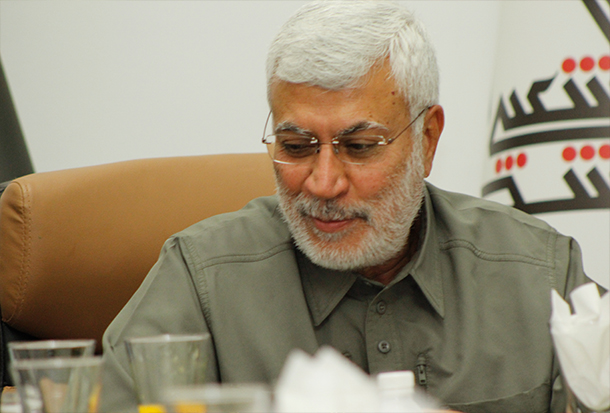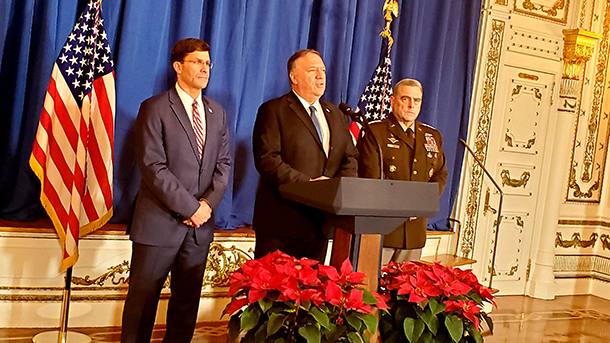Khazarian Jews all over are celebrating the successful assassination of the most revered Iranian commander, Qassem Soleimani, on orders of US Butcher Donald Trump.
One Jew York Times journalist tweeted what some consider a “eulogy” for Soleimani…
… to add insult to injury to every Iranian who’s now ready to take it to the next level.
In preparation for what’s to come, the Pentagon is now deploying 3,500 troops to the Middle East.
Here is the arrival of US troops in Baghdad, behaving like they truly own the place…
As in all previous wars, America will be united under this type of misadventure once again, and the momentum should be enough for Trump to survive the next election.
A simple formula that works all the time because America just love their military so much that only a few have dared questioned its consistently high military budget, even higher than all G7 military budget combined. [Yet, their favorite punching bag when it comes to their economic woes is China.]
Remember, that “on August 20, 1998, just weeks before Congress was set to vote on articles of impeachment against the philandering Democrat, Clinton ordered a cruise-missile attack on a Sudan factory on the grounds it was producing nerve gas for al-Qaeda. As it turned out, however, the destroyed factory was actually a pharmaceutical plant that employed thousands. “
The problem is, as opposed to the false flag demolition of WTC in 2001, a real threat of retaliation does exist, and the US has never won a war against anybody using guerilla tactics, especially in urban centers… right at home and abroad.
Khazarian Jews may have reasons to celebrate Trump’s Killing of Soleimani now, but a highly respected Iraqi commander also died alongside him and that’s a fatal mistake!
Trump’s Fatal Mistake in Iraq and Beginning of End for US Occupation
by Patrick Henningsen | 21st Century Wire
The United States may have just worn out its welcome in Iraq. Whatever comes next will be laid at the feet of the Trump Presidency.
As a result of a series of disastrous moves by US central command, the region now faces the very real prospect of another multinational conflagration in the Middle East, which could include a direct military confrontation between the US and Iran.
How It Began
This past Sunday December 29th, just before the New Year rang in, President Donald Trump gave the order to bomb an Iraqi military base, killing and wounding a number of Iraqi military personnel, including Iraqi Army officers, Iraqi police, as well as soldiers belonging to the People’s Mobilization Unit (PMUs). US Air Force F-15E fighters struck five targets located in Iraq and along the Syria-Iraq border, all said to be controlled by an ‘Iranian-backed paramilitary group,’ according to the Pentagon.
According to Washington defense spokespersons, Sunday’s US airstrike was supposedly in response to a rocket attack which struck the “K1” joint US-Iraqi military base located in Kirkuk in north Iraq, which happened just two days before on Friday December 27th, killing one U.S. defense contractor, and one Iraqi police officer, as well as wounding a further 4 US defense contractors, and 3 Iraqi Army officers. US officials claim they had intelligence which confirmed that Friday’s rocket attack near Kirkuk was the work of “Iranian militia,” therefore holding the Islamic Republic of Iran responsible. However, no evidence was presented by the US in relation to the claim.
In response to the US bombing its facility on Sunday, Iraqi protesters, including friends and family of fallen soldiers killed in the US bombing raid, and led by Iraqi PMU members and their supporters, stormed the outer perimeter of the US embassy in Baghdad located inside the infamous US-controlled Green Zone. Many US embassy staff were evacuated or airlifted from the compound, and an additional detachment of 100 US Marines were called in as reinforcements, along with an additional 750 troops from fast battalion 82nd Airborne Division sent to Kuwait preparing to go into Iraq. US combat helicopters circled overhead, as well as around the entire Green Zone and over civilians neighborhoods in Baghdad. This move was not received well by the Iraqi government who forbid such US military patrols as part of their status of forces agreement for the country. The siege lasted until News Years Eve on December 31st, before the Iraqi Army and Iraqi Mukhabarat internal security eventually arrived to disperse the angry crowds.
Following the embarrassing scenes at the US embassy on New Years Eve, Washington promised retribution. What followed could very well be the trigger for a renewed war in Iraq, and which may likely result in US forces and personnel eventually being asked (or forced) to leave the country. On Thursday January 2, 2020, the US launched another airstrike, targeting an access road leading to Baghdad International Airport, and reportedly killed Iranian Quds Force leader, General Qasem Soleimani, as well as senior Iraqi PMU commander, Abu Mahdi al-Muhandis, according to reports by Iraqi TV.

Iraqi PMU commander Abu Mahdi al-Muhandis in Baghdad following their defeat of ISIS in 2017 (Photo: Patrick Henningsen 2017©)
Both Soleimani and al-Muhandis are considered to be among Iran and Iraq’s most revered military figures, and their targeted assassinations by the US government will certainly be viewed as an act of war by a large portion of the Iraqi and Iranian populations, as well as their respective military and security apparatuses. In particular, al-Muhandis is regarded by many a hero in Iraqi’s hard-fought victory over ISIS in 2017.
Iraqi cabinet officials and parliamentarians have been meeting over the last 48 hours to discuss reviewing the status of their cooperation agreement with the United States which allows for intelligence sharing and US training and technical assistance for Iraqi military divisions. Whether this escalates into officials calling for the US military and its 20,000 troops and defense personnel to pack up and leave the country – remains to be seen.
It should go without saying that this provocative military action by the United States means that US troops and personnel may no longer be safe operating in Iraq.
Questioning US ‘Intelligence’
In order to grasp the full gravity of what the Trump Administration has just done, it’s essential to consider these events in historical context, as the latest reckless move in a long line of US failures in Iraq.
According to veteran Middle East correspondent Elijah Magnier, “The United States of America has fallen into the trap of its own disinformation policy, as exemplified by the work of one of its leading strategic study centres, a neocon think tank promoting war on Iran.”

Magnier adds, “Analysts’ wishful thinking overwhelmed their sense of reality, notably the possibility of realities invisible to them. They fell into the same trap of misinformation and ignorance that has shaped western opinion since the occupation of Iraq in 2003. The invasion of Iraq was justified by the presence of ‘Weapons of Mass Destruction’ which never existed.”
According to Iraqi officials, at the time of the initial rocket attack on Dec 27th, it was not clear who had actually fired on the K1 joint base. Regardless, a number of data points strongly indicate that the US had already decided who it would be targeting.
According to the New York Times, “President Trump was briefed by Defense Department leaders on Saturday, and allowed the strikes to proceed. Senior officials including Defense Secretary Mark T. Esper and Secretary of State Mike Pompeo traveled to Mr. Trump’s Mar-a-Lago resort in Florida on Sunday for discussions with the president, American officials said.”
The US had already taken the decision to bomb Iraq before any joint investigation could be conducted between the Iraqi Ministry of Defense and the US authorities. Soon after the Mar-a-lago meeting, Secretary of Defense Mark Esper called acting Iraqi Prime Minister Adil Abdul-Mahdi to inform him the US was not interested in working with Baghdad to find out what happened and who had fired the rockets. Esper told the Iraqi PM that Washington had already received “intelligence” from its trusted sources which said the rocket attack was carried out by a branch of the Iraqi PMUs known as Katiab Hezbollah (no relation to Lebanon’s Hezbollah defense force). It should be noted that these PMU brigades are composed of Iraqi citizens who serve under the official Iraqi military command headquartered in Baghdad. Because this PMU division’s membership is composed of Shia Muslims, United States officials and the US mainstream media have taken the liberty of labeling them as “Iranian militia” – a blatant falsehood, but one which has been disseminated by US officials in order to infer these are somehow ‘Iranian proxies’ and proceeded to pin the alleged responsibility of the initial rocket attack on Iran, in effect, justifying the heavy-handed US retaliation on Sunday, and Washington’s targeted assassinations of Qasem Soleimani, and Abu Mahdi al-Muhandis on January 2nd.

To date, US officials have provided no evidence to support their claim that the rocket attack on Dec 27th was carried out by Katiab Hezbollah PMUs, nor has the US given any specifics as to the provenance of its ‘intelligence’ which attributed blame to PMUs. If this was indeed a rush to judgement, it would not be the first time the US has perpetrated an act of war against a sovereign state based on faulty, and less than credible intelligence. The recent OPCW leaks have demonstrated beyond any doubt the US-led airstrikes against Syria in April of 2018 was based on misinformation of a supposed ‘chemical attack’ just days earlier in Douma, Syria on April 7, 2018.
Upon closer review, it’s now clear that what the US claimed it was doing, does not actually match the actions which it had undertaken on Dec 29th. In addition, the US bombing raid on Dec 29th will also have aided ISIS. Magnier explains the obvious US disconnect here:
Mr Abdel Mahdi asked Esper if the US has “proof against Kataeb Hezbollah to share so Iraq can arrest those responsible for the attack on K1”. No response: Esper told Abdel Mahdi that the US was “well-informed” and that the attack would take place “in a few hours”.
In less than half an hour, US jets bombed five Iraqi security forces’ positions deployed along the Iraqi-Syrian borders, in the zone of Akashat, 538 kilometres from the K1 military base (that had been bombed by perpetrators still unknown). The US announced the attack but omitted the fact that in these positions there were not only Kataeb Hezbollah but also Iraqi Army and Federal Police officers. Most victims of the US attack were Iraqi army and police officers. Only 9 officers of Kataeb Hezbollah – who joined the Iraqi Security Forces in 2017 – were killed. These five positions had the task of intercepting and hunting down ISIS and preventing the group’s militants from crossing the borders from the Anbar desert. The closest city to these bombed positions is al-Qaem, 150 km away.
Interestingly, this is not the first time that the US and allies have targeted an Iraqi PMU facility and tried to label it as “Iranian.” Back in September, 21WIRE reported how Israel and Saudi Arabia were reported to have launched supposed ‘retaliatory’ airstrikes against “pro-Iranian militias” stationed along the border between Syria and Iraq. This was reported by the Jerusalem Post at the time:
“Saudis, Israel attack pro-Iran militias on Syria-Iraq border,” and adding that,“Saudi fighter jets have been spotted along with other fighter jets that have attacked facilities and positions belonging to Iranian militias.”
21WIRE also noted how the Jerusalem Post had compiled their report citing multiple sources, including pieces of information from the Independent Arabia, Lebanese outlet Al Mayadeen and the Syrian Observatory for Human Rights. They reported air strikes hitting targets over the course of that week, killing 31, after hitting what they called “Iranian-backed” Iraqi Hash’d Shaabi (PMUs) positions along the Iraqi-Syria border.
“On Wednesday, five people were killed and another nine were wounded in an airstrike carried out by unidentified aircraft that targeted positions of the Iranian-backed Iraqi Popular Mobilization Forces militia in Albukamal, according to Sky News Arabia.”
Why this is crucial, is because it demonstrates previous form by Israel and Saudi Arabia – against near identical targets which the US bombed on Dec 29. It stands to reason then, that the ‘intelligence’ source for both attacks, on Sept 19th, and Dec 29th, seem to be related, deriving from either Israel or Saudi Arabia – both of which are heavily biased against Iran, and viewed it as an existential threat to their own regional geopolitical and military hegemony. In the case of Israel, it has played a visible role in directing US policy regarding Iran since the onset of the Trump Administration. It was Israeli PM Benjamin Netanyahu who boasted about his role in convincing the White House to unilaterally withdrawal from the JCPOA Iran nuclear deal in May 2018.
It’s also important to note with the US bombing raid on Sunday Dec 29th, the Iraqi bases hit along the Syrian-Iraqi border are located approximately 540km from Kirkuk, far away from where the US claim that Kaitab Hezbollah PMUs had fired the initial rocket attack on Dec 27th – which means that those US targets played no role in Friday’s rocket attack on K1, and more likely had already been selected in advance of Dec 27th, and the US was simply waiting for the right ‘incident’ to green-light a military attack on what it claims to be “Iranian” military targets.
Again, the fact that the US insists on mislabeling its supposed enemy means that nothing productive can come out of the latest series of events – unless Washington considers another full-scale war in Iraq a productive endeavor – a proposition which many would not find that far-flung considering America’s tawdry record in the region.

Iraqi PMU soldiers celebrate after their victory over ISIS in 2017 (Image Credit: PMU War Media)
Iraqi PMUs Defeated ISIS in 2017
In order to properly understand the Iraqi military and PMU’s reaction to this ham-fisted US attack on Iraqi soil, it is important to understand who are the Iraqi People’s Mobilization Units (PMUs), aka the Hash’d al-Shabbi, or ‘Hasheed’ for short. This is the new national militia of Iraq and are the very same soldiers who have fought and died against ISIS for ultimately defeating their terrorist occupation in late 2017. The PMUs were formed in response to the emergence of ISIS and the fall of Mosul in June 2014. The Grand Ayatollah Sistani issued a fatwa in the summer of 2014, which called on all able-bodied men of fighting age to form a coalition of national militias, roughly 130,000 strong, to fight back against ISIS after it had routed the Iraq Army during ISIS’s summer blitzkrieg which saw several key cities taken by the terrorist army, as they headed dangerously close to the capital city Baghdad. It was because of finiancial and military support from Iran at that time which allowed the PMUs to be formed and armed, and deployed to fight ISIS that summer, as well as the re-stocking of the Iraqi military arsenals which were depleted to dangerously low levels at the time of the initial ISIS offensive. Clearly, it was Iran who lifted up Baghdad in their hour of need, not the US whose principle contribution was not on the ground where it really mattered but rather flying air sorties which made little to no impact on ISIS advances between 2014 and 2016. It was only at the end of the ISIS wave in Iraq that the US began making a noticeable impact, although they appeared to chalk up more civilian casualties than anything else, during bombardments in places like Mosul, and Raqqa in Syria.
Based on the rhetoric and media coverage we are seeing this week, it’s painfully obvious that few, if any, within the ranks of American foreign policy ‘experts’ and national security journalists, are really aware of this reality on the ground in Iraq. It is widely acknowledged in Iraq, and in the region, that the PMUs played the decisive role in defeating ISIS and securing liberated communities in the latter stages of the country’s terrorist ordeal. It’s important to note also that tens of thousands of Iraqis, including Iraqi Army, Police, Iraqi civilians, and Iraqi PMUs – including these very same PMU units who the US has killed this week – have all died, sacrificing their lives for country in the fight against the foreign-backed terrorist menace. For the United States political leadership and mainstream media to crassly label them as “Iranian militias,” is to rob Iraqis of an important national victory and strip them of their agency.
As we can now see from the incredible scenes at the US embassy on Tuesday, Washington’s ignorance of the reality on the ground in Iraq has come at a heavy price.
WATCH: Thousands of Iraqi protesters furious over deadly U.S. airstrikes storm the American Embassy in Baghdad, breaking down doors and setting fires https://cbsn.ws/2MJw4Ym 6,22310:00 PM – Dec 31, 2019Twitter Ads info and privacy6,885 people are talking about this
Since its opening in 2008, the new US embassy has not faced any serious challenge to its structural integrity. It is not just any embassy either – it is the world’s largest and most expensive embassy ever constructed, covering a total of 104 acres which is roughly the size of Vatican City, and houses 5,000 embassy staff, military and intelligence personnel. Iraqi protesters breached its outer security walls and main gate, and proceeded to lay waste the embassy’s periphery structures, before pinning down US Marines guarding the compound inside the foyer of one of the outer reception buildings. Now that this facility has been compromised, it can no longer be relied on as the ‘fortress America’ and forward operating station it has been for the past decade.
Trump and Washington’s Fundamental Error
Another important takeaway from all of this is for Americans to realize that Iran posed no national security threat to the United States, but Washington’s insistence on framing every incident in the region as “the work of the Iranian regime” means that forces in Washington desperately want war, and now they can’t hide their agenda. This drive is most certainly being spurred on by US allies in the region, Israel and Saudi Arabia. From an imperialist standpoint, the US and its allies do benefit geopolitically by keeping Iraq divided and weak – ensuring that it can never get back on its feet economically or politically to become influential in the region, and can never become close partners with its two most important neighbors Syria and Iran.
For Washington and Tel Aviv, the road to Tehran has always been through Baghdad, only we’re not in 2003 anymore, and the Middle East playing field has changed dramatically since that time, mostly as a direct consequence of US military and proxy aggression in the region.
Besides this, Iraqis are well aware by now that it is the United States and not Iran, who has already ruined their country for generations to come.
If Washington continues down this path, it could also lead to Trump’s downfall politically.
Unfortunately, Iraq is set again to become the pitch for another ugly geopolitical grudge match between the West and Iran. By showing its ugly hand, Washington has left its adversaries with little choice but to fight back this time.
Author Patrick Henningsen is an American writer and global affairs analyst and founder of independent news and analysis site 21st Century Wire, and is host of the SUNDAY WIRE weekly radio show broadcast globally over the Alternate Current Radio Network (ACR). He has written for a number of international publications and has done extensive on-the-ground reporting in the Middle East including work in Syria and Iraq. See his archive here.
For the political survival of one man, in the service of the Israel Lobby, the entire US population is being put under threat of retaliation — is that a fair bargain?


